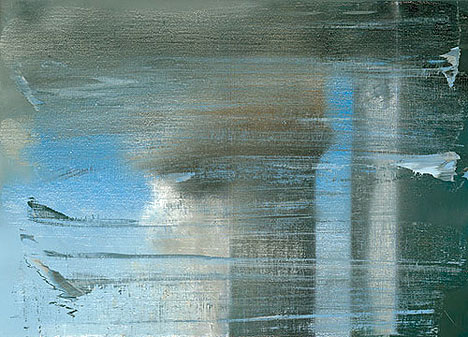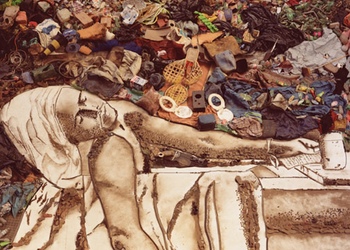It has been ten years since the devastating attacks on the World Trade Centre and many tributes and analyses are appearing in the media. So much has been written on the astounding and tragic events of 9/11, both at the time and subsequently, that it is difficult for me to know what I can add.
How can art respond to war? I couldn’t resist re-posting this image from a thought-provoking article published last month in the Sunday Times Culture magazine by Bryan Appleyard which addressed this question (28/8/11). For me, this quietly powerful painting, like a lot of Richter’s work, falls within the Romantic tradition and exploration of the nature of the sublime. The 19th-century interpretation of the sublime as something astounding, awe-inspiring, almost un-knowable was formed in relation to man’s concept of the natural world. Here Richter inverts this tradition, painting the almost unbelievable moment that the second plane ploughs into the south tower an act of terrorism seemingly un-knowable. The familiar landmark of the towers is barely visible here as though seen through clouds of carcinogenic dust, ash and soot that their destruction released into the air and which continues to poison those New Yorkers who breathed it in. Curator Robert Storr has written about this picture and says that the unsettling nature of the image is due to its indeterminate depth of field and lack of vanishing point as well as all the baggage of his/her own that the viewer brings when looking at it. Each one of us already has our own visuals of the event as the dramatic media images unfolded live before our eyes as people everywhere watched stunned, glued to the television. Storr continues, September states nothing This is a figment rather than a record of history. Compared with what eyewitnesses can recall even with the passage of time and what video and photography have captured and preserved, Richter’s version or, better said, vision of 9/11/01 is an eroded representation of a monument blown to smithereens, the ghost of a ghost.
It is both representational and abstract and it is the tension between the two that makes this painting more interesting than a documentary photograph. Storr again: The sense that the image dissolves in front of your eyes is literally part of the illusion.
This modern take on history painting is to be included at a major retrospective of Richter’s work which opens next month at Tate Modern (6 October to 8 January 2012).
I found Why Art failed Us After 9/11 by Nick Gillespie on a similar subject fascinating.
A discussion of what place memorials can have by Simon Schama in the FTWeekend (The Remains of the Day Sept 3-4, 2011), was also well worth reading and described the permanent memorial currently being finished by Arad and Walker at the World Trade Centre site, which will include a museum due to open next year. This prompted me to remember a trip I made to Berlin not long after the wall had come down when I happened by chance upon a memorial by Israeli artist Micha Ullman in the Bebelplatz. This is the site of the infamous Nazi book burning of May 1933. I have a fascination with memorials and the relationship of artists in the creation of these; I would love one day to embark on a project recording and researching particularly war memorials around the world. I have never forgotten this particular memorial for its profound subtlety and aspect of supreme quietness. Nothing is visible above ground as you gaze across the grand, 18th-century architecture of the square; it is not until you are almost on top of it that you notice a small window into the pavement and peering through, realisation dawns that you are looking at row upon row of empty bookcases, partially illuminated by the sun that streams in at an angle. A world without books would be very quiet indeed.
But should it ‘just’ be about memorials? If art reflects the state of the society in which it is made we can look to it to offer clues as to why life is the way it is. Shouldn’t we be seeking a more active role for art, other than memorialising the dead (important though that is)? Art that is interactive and participatory has the power to change people’s lives in the here and now. Brazilian artist Vic Muniz’s inspiring work with garbage pickers in the world’s largest dump outside Rio de Janeiro shows this concept in action to profound effect (documented in the brilliant film Waste Land – easily my favourite art documentary). Muniz’s project highlighted people who tend to be overlooked by society, who felt disenfranchised and gave them a voice in a positive way. Terrorists also want to be heard, whether we wish to acknowledge their complaints as valid or not. Of course this does NOT give anyone the right to perpetrate violence under any circumstances. However surely dialogue is the way forward (look what happened in Northern Ireland when the various parties finally started talking). Buckminster Fuller believed that we are all equal members of one global system and we all need to manage this to keep it in balance. Surely the majority of people would rather see Art than War. Artists occupy a uniquely valuable position they act as creative mediators and facilitators between objects and experiences (real or imagined) and viewers/participators/the rest of us. Let us make more use of them where it counts.


